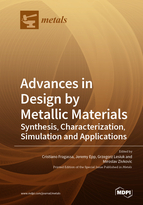Advances in Design by Metallic Materials: Synthesis, Characterization, Simulation and Applications
A special issue of Metals (ISSN 2075-4701).
Deadline for manuscript submissions: closed (31 December 2020) | Viewed by 44338
Special Issue Editors
Interests: mechanical engineering; advanced materials; materials engineering; structural analysis; composite material; mechanical design; manufacturing engineering; quality in industry
Special Issues, Collections and Topics in MDPI journals
Interests: material characterization; steel; heat treatment; mechanical behaviour of materials; microstructure; X-ray diffraction; residual stresses; surface integrity; materials processing; additive manufacturing
Special Issues, Collections and Topics in MDPI journals
Interests: fatigue damage; reliability analysis; fatigue crack growth theory; failure analysis of metal materials; micromechanics of materials; multiscale materials modeling
Special Issues, Collections and Topics in MDPI journals
Interests: advanced finite element simulations; structural analysis of metallic structures; continuum mechanics; fatigue; damage mechanics
Special Issues, Collections and Topics in MDPI journals
Special Issue Information
Dear Colleagues,
Very recently, a great deal of attention has been paid by researchers and technologists to trying to eliminate metal materials in the design of products and processes in favor of plastics and composites. After a few years, it is possible to state that metal materials are even more present in our lives and this especially thanks to their ability to evolve. This Special Issue is focused on the recent evolution of metals and alloys with the scope of presenting the state of the art of solutions where metallic materials have become established, without a doubt, as a successful design solution thanks to their unique properties. The Special Issue also intends to outline the fundamental development trends in the field together with the most recent advances in the use of the metallic materials—Synthesis, advanced experimental characterization, material modelling and engineering applications. All these topics will be covered in this collection of contributions, as will a large assortment of metals and alloys, including steel, cast iron, aluminium, light alloys, precious and non-precious alloys, metal matrix composites, etc., together with their use. In terms of processes covered include traditional processes such as casting, deformation or material removal, but special attention will also be dedicated to the newest processes, such as laser sintering, rapid manufacturing and so on. Contributions will be considered noteworthy if they represent a real element of novelty in the world of metallic materials as well as in the advanced characterization and use of metals for effective design solutions.
Prof. Cristiano Fragassa
Dr. Jeremy Epp
Dr. Grzegorz Lesiuk
Prof. Miroslav Zivkovic
Guest Editors
Manuscript Submission Information
Manuscripts should be submitted online at www.mdpi.com by registering and logging in to this website. Once you are registered, click here to go to the submission form. Manuscripts can be submitted until the deadline. All submissions that pass pre-check are peer-reviewed. Accepted papers will be published continuously in the journal (as soon as accepted) and will be listed together on the special issue website. Research articles, review articles as well as short communications are invited. For planned papers, a title and short abstract (about 100 words) can be sent to the Editorial Office for announcement on this website.
Submitted manuscripts should not have been published previously, nor be under consideration for publication elsewhere (except conference proceedings papers). All manuscripts are thoroughly refereed through a single-blind peer-review process. A guide for authors and other relevant information for submission of manuscripts is available on the Instructions for Authors page. Metals is an international peer-reviewed open access monthly journal published by MDPI.
Please visit the Instructions for Authors page before submitting a manuscript. The Article Processing Charge (APC) for publication in this open access journal is 2600 CHF (Swiss Francs). Submitted papers should be well formatted and use good English. Authors may use MDPI's English editing service prior to publication or during author revisions.
Keywords
- Design Solutions
- Material Design
- Metal and Alloys
- Metalworking
- Metal Properties
- Advanced Characterization Methods
- Processes and Treatments
- Numerical Modelling
- Design Industry









